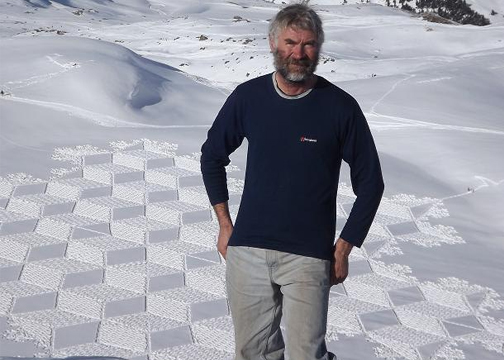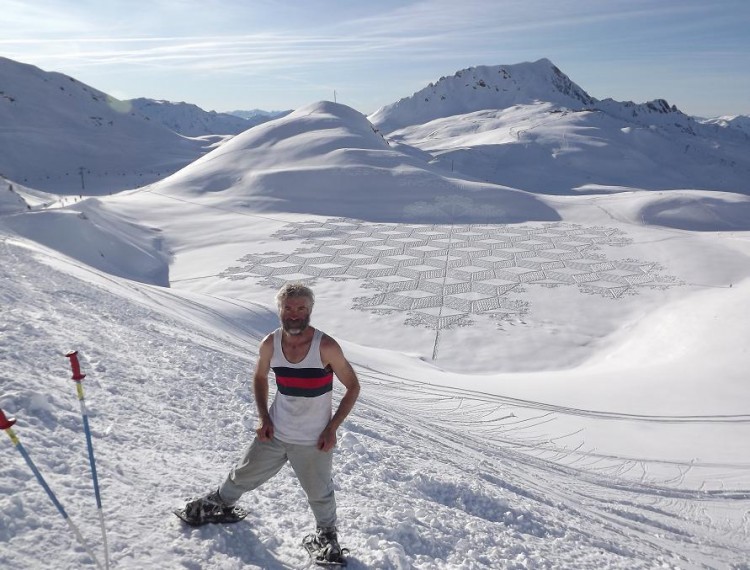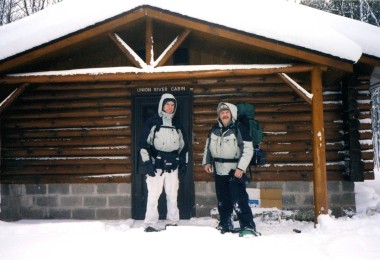Familiar textured snowshoe tracks leave intricate, almost filigree shadows on a pristine slope in the French winter slopes. The pattern they leave evokes a mystery – who left these here? And invite the viewer to contemplate them amid the quiet winter’s day. Sometime in the last 48 hours, a snowshoer has been out since before sunrise, leaving tracks in the snow that reminds one of a crop circle. It’s just as massive, covering an area roughly the size of several football fields. There is no sign of the artist.
Since 2004 in Les Arcs France at Arc2000, dozens of geometric patterns began to appear each winter with the first snowfall. The designs range from purely geometric shapes to architectural references. They are laid down with focused concentration, taking two days to complete at times, by one man, snow artist Simon Beck, of England.
Some of the links in this article may contain affiliate links. When you make a purchase using these links, part of the proceeds go to Snowshoe Mag. Additionally, as an Amazon Associate, we earn from qualifying purchases. Please see our disclosure for more details.
The Start of Snow Art
Beck apparently completed his first snow art — a five-pointed star joined by circles — sans snowshoes. He so liked the look of it that he tried a ten-pointed star next. But that was such “hard work,” he decided snowshoes would make it easier. Beck’s solitary efforts took on a quality recognized as true art today when he discovered a lake nearby and played with patterns and evolving techniques that made the process easier over time.
Beck designs on lake beds and pristine mountain slopes are weather and avalanche-dependent and completed anywhere from six hours to two days.
Beck’s map-making skills and competitive orienteering in the off-season informed his process from planning to completion of these mammoth icons of environmental winter art in an unusual mixture of skill sets.
In 2004 he had to back off from orienteering due to a serious injury to both his feet. He discovered that snowshoeing avoids too much “…load on the front of the foot,” where the injuries are. Then, it followed that buying a condo on the mountain where he can “walk out the door to the slopes” made sense. “If you own an apartment and have a season ticket,” he said, he could afford the new lifestyle. “I do quite a lot of skiing too. I just like being in the mountains.”
But Beck noted this was a rather radical change in his lifestyle at the time as he “… didn’t learn to ski until I was 44.” He could not afford the lifestyle without selling his house in England first. As for snowshoeing, “When I started out doing it, it was just a bit of fun in the evening.”
Beck is in superb shape from competition orienteering and spends a lot of time hiking and running through the mountains.

One of Beck’s gorgeous and elaborate designs in the snow can take anywhere from 6 hrs to 2 days to complete. Photo: Simon Beck
The Process
It is also during the summer when he spends time drawing and preparing his designs, so he can get out and start making tracks as soon as winter returns. Over the last several years, Simon Beck has also begun making art in the sand. To date, he has over 330 snow drawings and 120 sand drawings.
“I usually see a drawing and think, let’s do that in snow …so they are not all original designs. He said the designs are a means to an end.
In the beginning, when Beck was on his own, he “…started noticing what direction the sun was shining from affected which direction to walk to get the greatest contrast.” So, he chose a site for a design considering the angle and direction of the sun for the photographs. “…The key thing is to get photos,” he mentioned. Over the years, Simon Beck has invested in upgraded equipment for higher resolution images of his snow art.
Being a map surveyor comes in handy in marking and laying out the design before he begins. “The setting out is done using handheld orienteering compass and distance determination [is done] using pace counting or measuring tape. Then, curves are either judged, or arcs of a circle [drawn] using a clothesline attached to an anchor at the center,” Beck explains on his Facebook page. “This can take 25 percent of the total time.”
During the process of tramping out the snowshoe design, “I try not to think about things as it is too easy to make a mistake.”
But, Beck said, “Once [he draws] the lines …it is just a matter of filling in …[then] I listen to [classical] music,” Beck described. “Most of my thoughts [are] fantasizing …where new ski lifts might be built, where the high-speed railway lines should be routed, how the road up to the resort should have been aligned and, naturally, bigger and better snow drawings!”
The process is pretty impressive. Just check out this time-lapse.
Read More: Winter Photography Tips for Snowshoers

Beck mentioned that the first snow is ideal, and he typically prefers 4-6 inches for his drawings. Photos: Simon Beck
The Conditions
Another factor Simon Beck has to consider as a snow artist is the conditions. As Beck states, “The first snow is ideal,” as he prefers four to six inches of snow. Any deeper, and he sinks in, and it’s “harder to walk. It takes longer, and I get tired sooner.”
He prefers using TSL snowshoes, which are crafted in France, in the thirty inch-size. “They feel about right for doing snow art. There have been very few occasions when I’ve sunk in too far [on smaller ones].”
Beck also prefers frozen lakes, of which there are several to choose from at Arc2000. However, until the ice is thick enough to walk on, he has plenty of mountain slopes to choose from.
And, he needs a location that is likely to remain pristine – a least until he takes the image. Les Arcs provides enough space to keep him busy through the spring.
Once he chooses a site, he starts the day early. “I do assessing of conditions” and stays off the slopes on “days of avalanches. I can’t actually get to a site until it is safe.” One design may take as long as two eight-hour days.
He does not often come back the next day to complete a design because conditions are rarely the same, but Beck recently completed ‘Waterbowl29’ [“… the 29th drawing done in the water bowl”], and “It took two days, about 16 hours…”
In contrast, “The ‘StJacques14’ […because it is in the flat area under the St Jacques lift] … took about 6 hours … [completed Nov. 8].”
“It’s all about a good image and good contrast. The shadow is what really makes the design…the direction the sun is and which way to walk to get the greatest contrast…” Beck emphasized.
Read More: Why All Snowshoers Should Be Avalanche Aware (Even Beginners)

“This is waterbowl29 because it is the 29th drawing I have done in the water bowl. It took two days, about 16 hours, and [I completed it on] November 17.” –Simon Beck They call this area the water bowl because Acr2000 takes the water supply from here. Photo: Simon Beck
The Challenges of Snow Art
He claims to be “… a bit of a loner so being on my own …” is natural. “I am quite accustomed to pain and exhaustion.”
But there are extreme hazards, and Simon Beck said he is aware that he often works on his snow art after the lifts close. “Mountains are dangerous [and] once the ski runs are shut, you are on your own.”
He said one could “…very suddenly become exhausted. It’s like hitting a wall — you suddenly run out of steam. You need to have both food and warm clothing with you.” When enough is enough, “…is a matter of making a judgment call [one is] too tired and too cold and cannot make it back home.” He said even “…just the process of putting on warm clothes” when he stops can put him over the edge.
“…Once I got really cold when I was getting changed, and I couldn’t get my boots on properly. I was really lucky I was only a quarter of an hour from home.” But, he admits it would “…obviously … be safer with two people so one can go for help.”
Read More: Book Review: Hypothermia, Frostbite, and Other Cold Injuries

Snow art can also come with its challenges, including exhaustion and dangerous conditions. Photo: Simon Beck
His Fame
Simon Beck said his fame as a snow artist spread mainly “due to the internet” and his Facebook page, which has over 275K followers. “It is [considered] art now.”
Beck was also given the Most Extreme Art award by the Society of Unique Artists for his snowshoe art in 2012. Furthermore, he has a short documentary about him, Simon Beck – Snow Artist, created in 2016. Several years ago, Beck also put together a book of his images available on Amazon.
Over the years, he said he has also created several logos for snowshoe companies like Tubbs but admits that there is a “bit of an issue” advertising on mountain snow as an artist. “I am not sure where enough is enough for advertising like actually doing text in an [advertisement],” he mused.
On his bucket list was “the North of Norway in Sammi country …where there are big sites and low sunlight that brings out the contrast,” Beck muses. “With some really good equipment and given an unlimited budget, the long exposure of northern light – the sunlight in Scandinavia — makes it extremely attractive.”
To see more of Simon Beck’s snowshoe art, visit his Facebook and Instagram pages.

“This is StJacques14 because it is in the flat area under the St Jacques lift.” –Simon Beck. Photo: Simon Beck
Have you seen the works of snow artist Simon Beck? Please share your thoughts in the comments below.
This article was first published on December 11, 2012. Susan Wowk most recently updated the article on July 21, 2021.
Read Next: The Art of Urban Snowshoeing







Dude!
ABSOLUTELY AMAZING! I CAN’T EVEN IMAGINE THE TIME AND EFFORT SIMON BECK DEVOTES TO CREATING THESE MAGNIFICENT DESIGNS….TRULY HE HAS MASTERED THIS ART FORM….I’M PLEASED TO HAVE HAD THE OPPORTUNITY TO VIEW HIS WORK….THANK YOU …ROBIN
Sweet!